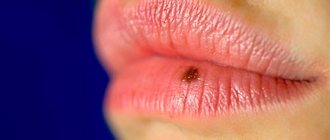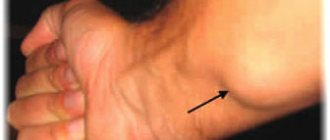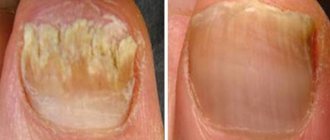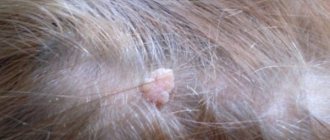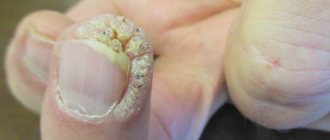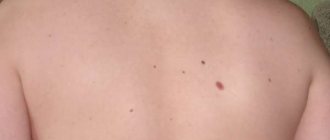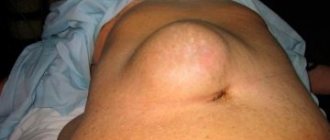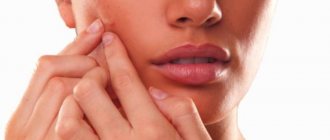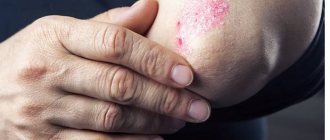Types of wart growths
The skin of the lips is quite thin, which makes it easier for the virus to penetrate it. Most often, warts on the lips are localized:
- on the mucous membrane;
- on the red border of the lips;
- in the inner zone.
Warts are classified as follows:
- flat – oval neoplasms that practically do not rise above the skin;
- ordinary - dense nodular neoplasms with uneven edges;
- pointed - flesh-colored or pink nodular formations, most often located on the mucous membranes;
- hanging – brown or flesh-colored growths reaching 1 cm;
- threadlike.
Outside
These warts are more a cosmetic than a physiological defect. These neoplasms most often do not pose any threat to health, but this location of the growth makes it quite vulnerable. The wart can be injured by overly active facial expressions or while eating.
On the inside
Warts on the inside of the lip do not affect aesthetics, but can cause discomfort while eating or talking. Quite often, growths on the inside of the lip impair diction.
Important!
Lumps on the lips can be signs of many pathologies, so consultation with a doctor is mandatory.
What do warts on the lip look like?
Photo of warts on lips
Since the papillomavirus has many different types, the neoplasms it causes can have different appearances. Warts on the lips can be like this:
- Vulgar (simple) . Such growths are most common. They are caused by non-oncogenic strains of the virus. They look like small skin nodules. Their surface is uneven, as if wrinkled, and there is no skin pattern. The size is usually within a few millimeters. But occasionally such growths can grow and reach a diameter of 15 mm. Initially, these neoplasms do not differ in color from the shade of healthy skin around them. But the older the wart vulgaris, the more likely it is that it will darken, become more pronounced and brighter. As a rule, these growths are painless and do not cause any discomfort.
- Flat (youthful) . This type of neoplasm protrudes several millimeters above the surface of the skin. They have a round shape and clear contours. Usually do not reach large sizes. Their surface is smooth and even. The color is no different from healthy epidermis. As a rule, such warts on the lips affect teenagers and tend to go away on their own.
- Condylomas acuminata . These are also neoplasms caused by HPV, but they differ significantly from the warts described above. Condylomas are considered a manifestation of an infection provoked by oncogenic strains of papillomavirus. Most often, infection with condylomas occurs through oral sex. They look like cockscombs fused together. The shade rarely differs from healthy skin. They can affect both the outer and inner parts of the lip and mucous membrane. Sometimes they can provoke skin itching and burning in the affected area.
- Filiform . They are also called acrochords. These warts on the lip can be elongated, oval, or round. They are attached to the skin with a thin stalk. They have an elastic, slightly loose structure. They can form groups or appear singly. They do not cause discomfort, but can be easily injured due to their shape.
Reasons for appearance
You can become infected with the papilloma virus through close contact with a carrier of the virus - kissing, oral sex, sharing a toothbrush, etc.
You need to know that the infection may not become active immediately after entering the human body; its incubation period can last from several weeks to several years. The awakening of the virus can provoke:
- avitaminosis;
- poor nutrition;
- pregnancy;
- smoking, alcohol abuse, drug addiction;
- poor oral care;
- diseases of the immune system;
- chorionic pathologies.
Are they dangerous?
Warts on the lips are not an easy cosmetic defect to accept. They are often injured, therefore there is a risk of infection and inflammation. The pathological process can spread to the entire oral cavity, to the larynx and even deeper.
Over time, others may appear next to one wart, and in this case, the cosmetic defect will intensify.
Important!
Since the skin on the lips is very delicate and the blood vessels are located close, sometimes prolonged exposure to the sun or other provoking factors can give impetus to the transformation of a benign wart into a malignant pathology. Fortunately, such cases are quite rare.
What is the danger of warts on the lip?
Warts on the lip are, first of all, a pronounced cosmetic defect. They are located on a noticeable area of the face and can cause certain psychological discomfort in a person. However, in addition to this, they also pose a certain threat to the patient’s health.
Many people who first encountered this pathology are interested in what to do with warts on the lip. The answer is clear: treat under the supervision of a doctor. These are viral formations, which means that a person is an active carrier of HPV and poses a potential threat to others.
In addition, some warts can be caused by oncogenic strains of papillomavirus. This means that sooner or later the growths can degenerate and become malignant tumors, which require much more serious treatment than simple benign tumors.
There are many factors that can cause malignancy of warts on the lip. First of all, this is injury to growths. In the case of lips, this happens quite easily, since the integrity of thin and delicate skin and neoplasms here can be damaged by teeth, food, hands, and clothing.
Even if an injury to a wart does not lead to its degeneration, it can cause severe bleeding, inflammation, and the addition of an additional infection followed by suppuration.
Also, warts on the lips can grow, interfere with eating, speaking, and cause speech defects. When exposed to frosty air, painful cracks and crusts appear on these formations.
There is also a risk of self-infection. This happens especially often in children, when when the patient frequently touches the wart, he spreads the virus throughout the body. For this reason, pathological growths may appear in other areas.
Hardware treatment methods
Hardware techniques allow you to remove growths as carefully as possible, without affecting healthy areas of tissue. Most often used:
- laser removal;
- electrocoagulation;
- radio wave destruction.
The use of these methods is aimed at evaporating liquid (laser) or burning (radio waves, electric current) pathological tissues.
As a result, a scab forms at the site of the growth, which falls off over time, leaving no trace behind. Hardware techniques are minimally invasive and give positive results in one session.
Laser removal
The advantage of laser removal is that the laser beam penetrates the skin to the required depth, and a specialist can control this process, preventing damage to healthy tissue.
After the procedure, there will be no mark left on the lips and no scar will form. However, there are contraindications for the procedure:
- herpes;
- some cardiovascular pathologies;
- diabetes;
- some chronic diseases.
The recovery period after wart removal is several days.
Radio wave therapy
Also a very common and effective method for removing skin growths. The procedure is carried out using a special device that emits high-frequency waves.
The peculiarity of this method is that the radio wave affects the place where the wart is attached to the skin. This technique is low-traumatic, painless, fast, and scars after the procedure are very rarely left.
Electrocoagulation
Bloodless method for removing growth on the lip. It is carried out using a high-frequency current, which is closed in a loop.
Other methods of removing growths
Radical treatment (removal) must be done in medical institutions. Today there are several methods. So, how to get rid of it? This is possible thanks to:
- eradication using liquid nitrogen or dry ice (cryodestruction);
- removal by electric current (burning out, electrocoagulation);
- removal by a laser beam;
- surgical excision (with a scalpel under local anesthesia).
All methods differ in the degree of impact on the skin, and of course in price. The safest method, based on your specific case, should be determined solely by your doctor.
Medications
Drug therapy consists of the use of antiviral and immunomodulatory drugs of local and general action. In addition, burning ointments and freezing creams can be used to remove warts.
Immunomodulators
Most often prescribed:
- Anaferon.
- Immunal.
- Arbidol.
- Echinacea extracts and tinctures.
These remedies are quite effective, but treatment will take time. It is not recommended to take immunomodulatory drugs on your own, as they have a number of contraindications, and only a specialist can choose the appropriate drug and prescribe the optimal dosage and duration of treatment.
Burning ointments
Acetylsalicylic ointment - softens any neoplasms, stops the inflammatory process and disinfects. The growth should be treated in a thick layer once every 3 days.
- Super celandine is an aggressive agent that burns out neoplasm cells. Not recommended for use on mucous membranes. The cream must be applied very carefully so as not to get on healthy tissue. An effective remedy for both new and old warts.
- Condyline is a very strong drug that burns out the tumor in just a few applications. Application to healthy tissue is not allowed.
- Vartek - destroys wart tissue due to a high concentration of asthenia podophila oils. Causes burns if it comes in contact with healthy skin!
- Solcoderm - burns the wart with nitric acid and copper nitrate. This drug is preferably used only by specialists.
Freezing creams
- Cryopharm is available in the form of a roller applicator that freezes tumors. You just need to touch the wart with the head of the applicator several times at intervals of 15–40 seconds. When the drug comes into contact with healthy tissues, their death is possible.
- Wartner is an effective freezing agent, the principle of action and application of which does not differ from the previous drug.
It must be said that the procedure for freezing a wart at home is quite painful and traumatic. Prohibited for children under 4 years of age and for patients with diabetes.
Folk remedies
In folk medicine there are a large number of remedies that help fight skin growths. It is very important to consult a doctor about its safety before using any product.
Many recipes are based on the use of poisonous plants and aggressive agents, so caution should be used.
Treatment with celandine juice
The plant is poisonous, therefore it has a detrimental effect on pathological tissues. The juice of the fresh plant is used. Before the procedure, it is necessary to rinse the area with the growth well and apply a rich cream to the healthy tissues around the wart so that the juice does not cause burns or irritation to them.
Then celandine juice is applied pointwise to the neoplasm. The procedure is carried out twice a day until the growth completely dies.
Important!
This method is not suitable for treating warts located on the mucous membrane.
Vinegar rubs
6 or 9% table vinegar is used; due to its strong acidic properties, this method leads to tissue necrosis. The direct effect of vinegar is to wipe the wart several times a day.
The product should be left on the neoplasm for 5–7 minutes, then rinsed off with water. Not suitable for removing warts located on the mucous membrane.
Garlic compresses
It is necessary to steam the area with the growth and apply a thin slice of garlic to it. To keep the compress in place, it should be secured with a band-aid.
Almost immediately after applying the compress, a burning sensation appears, you must endure it - it will not last long. The compress is left for about 30 minutes, then the affected area should be washed with running water. This treatment can be carried out for no more than 3 weeks.
There is another recipe for a compress with garlic. You will need garlic gruel and some rye flour. Mix everything in equal quantities and apply to the wart overnight, securing the compress with a band-aid. In the morning, the skin should be rinsed well.
Treatment of warts at home with folk remedies must be supervised by a doctor, since not all tumors can be eliminated using similar methods.
Prevention
90% of the inhabitants of our planet are infected with the papilloma virus, and the only effective way to prevent its penetration and development in the body is vaccination, but it should be carried out only before engaging in sexual activity.
As for other preventive measures, they include maintaining personal hygiene, avoiding close contact with the virus carrier, proper nutrition, timely treatment of all diseases and strengthening the immune system.
If the virus is already present in the body, and pathological growths have appeared on the lips, this is a good reason to undergo a comprehensive examination and correct the problem in the immune system.
Reasons for the formation of papillomas around the oral cavity and possible locations of their localization
The appearance of all types of papillomas is associated with infection of the patient with the human papillomavirus (HPV). The prevalence of this type of viral agent is very high and reaches 90% of the population in some countries. However, HPV carriage is not always accompanied by the formation of skin tumors.
The virus can remain latent for a long time without manifesting itself at all.
The formation of papillomas is promoted by factors such as decreased immunity, bad habits, poor nutrition and hormonal imbalance.
Science knows more than 100 types of human papillomavirus. The location of the tumor directly depends on the type of HPV. Papillomas in the mouth, covering the surface of the mucous membrane, are caused by HPV types 13 and 32, affecting various parts of the oral cavity:
- The tongue most often undergoes epithelial hyperplasia, which is usually manifested by the formation of fine granularity or single tubercles of the mucous membrane of the tongue
Papillomas on the tongue. The tongue most often undergoes epithelial hyperplasia, which is usually manifested by the formation of fine granularity or single tubercles of the mucous membrane of the tongue. In the first case, multiple small growths are felt as an unpleasant roughness of the surface, while the second type of neoplasm, being quite large, is often injured and causes its owner not only discomfort, but also pain. Papillomas on the tongue usually appear in the tip or lateral area organ parts. Papilloma under the tongue can also be considered a frequent occurrence. The root of the organ is least likely to suffer from such growths. The color characteristics of papilloma vary from light pink to bright red.
- Papilloma in the throat. Papillomas in the throat can remain undiagnosed for a long time, since they usually do not cause significant pain in the patient. Owners of such neoplasms of the mucous membrane note minor discomfort and sore throat, which is not given any importance. If the papilloma increases in size, it can interfere with normal food intake and even change the voice of its owner, making it more muffled. The growth itself usually looks like a soft whitish or one-time bump with a rough surface. Papillomas on the tonsil are especially common.
- Laryngeal papilloma. One of the most unpleasant types of localization of neoplasms.
The fact is that the formation of laryngeal papillomas interferes with the breathing process, which can lead to acute hypoxia. This phenomenon is especially typical for young children who cannot clearly formulate complaints about difficulty breathing.
- Papilloma on the lip. Such epidermal growth usually causes more trouble from an aesthetic point of view than from a physiological point of view. However, excessive growth of the tumor increases the risk of injury during eating or active facial expressions.
- Papilloma on the gum. Usually characterized by the absence of symptoms and any pain. If a papilloma on the gum has formed in a place that is invisible to the patient. It can only be detected by visiting a dentist.

